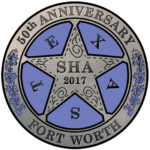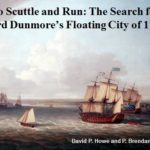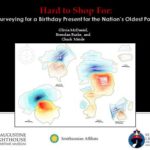 Every January, one or more of our Lighthouse archaeologists attend the annual Society for Historical Archaeology (SHA) conference, where professionals and students from across the field of historical and underwater archaeology gather to present their research. While we usually share our research with the public through various forms of outreach here at the museum and in nearby communities, these conferences provide opportunities to present our research to the academic community.
Every January, one or more of our Lighthouse archaeologists attend the annual Society for Historical Archaeology (SHA) conference, where professionals and students from across the field of historical and underwater archaeology gather to present their research. While we usually share our research with the public through various forms of outreach here at the museum and in nearby communities, these conferences provide opportunities to present our research to the academic community.

No trip to SHA is complete without learning a bit about the host city’s own history. As any Fort Worth local will tell you, no trip to the city is complete without a visit to their historic stockyards.
This year, Chuck Meide, Brendan Burke, and I attended the 50th Annual SHA conference, held in Fort Worth, Texas. Between us, we presented four papers on research spanning from St. Augustine to the Potomac, participating in a session titled Strategic Partnerships in Archaeology: A Community Approach to Raising Awareness and Preserving Maritime Heritage. The session focused on research and discoveries that resulted from various partnerships between federal, state, academic, and non-profit organizations, including our own research arm, the Lighthouse Archaeological Maritime Program (LAMP), the State of Florida, the Naval History and Heritage Command (NHHC), the Institute of Maritime History (IMH), and the Battle of the Atlantic Research and Expedition Group (BAREG). You can find the abstracts for each of LAMP’s papers below.
Our papers and research were well received, and it was a great way to highlight the partnerships among our different organizations, as well as those between our organizations and the community and student volunteers who regularly work with us in the field.
Among other exciting news from the conference, we got our first look at the Advisory Council on Underwater Archaeology 2016 Proceedings, which features sixteen papers written by lighthouse archaeologists, collections and interpretations staff, and students, mostly concerning our work on the Storm Wreck, which is currently featured in our Wrecked! exhibit here at the museum. If you missed it last year, you can find the abstracts and write up for these presentations at least year’s SHA here.
That’s all for now, but stay tuned for next time when you’ll get a preview of what this coming field season and our annual field school in underwater archaeology have in store.
2017 SHA abstracts:
 P. Brendan Burke (Lighthouse Archaeological Maritime Program) Five Sites, Sixty Miles, and Nine Tons of Discovery: Spring 2016 Research On and In the Potomac River
P. Brendan Burke (Lighthouse Archaeological Maritime Program) Five Sites, Sixty Miles, and Nine Tons of Discovery: Spring 2016 Research On and In the Potomac River
The Institute of Maritime History (IMH) and the Lighthouse Archaeological Maritime Program (LAMP) partnered for a research initiative in the Potomac River from May 12-20, 2016. The multi-phase project investigated several sites including the USS Tulip, the wreck of the Confederate schooner Favorite, the WWII U-boat Black Panther (U-1105), a 19th century centerboard sailing vessel, and a canal barge scuttled in 1862 with heavy ordnance once used to blockade Washington D.C. Additionally, survey was undertaken as a continued effort to locate scuttled vessels from Lord Dunmore’s 1776 fleet. High resolution acoustic imagery and magnetic data was gathered on each site and diver investigation was undertaken at one site. This paper provides an overview of the project’s results and emphasizes the continued need for avocational/professional partnerships
 David P. Howe (Institute of Maritime History), P. Brendan Burke (Institute of Maritime History) To Scuttle and Run: The Institute of Maritime History’s Search for Lord Dunmore’s Floating City of 1776
David P. Howe (Institute of Maritime History), P. Brendan Burke (Institute of Maritime History) To Scuttle and Run: The Institute of Maritime History’s Search for Lord Dunmore’s Floating City of 1776
Since 2008 the Institute for Maritime History (IMH) has supported a research project at the confluence of the St. Marys and Potomac rivers. This area is the suspected locus of Lord Dunmore’s scuttled fleet from 1776. As the last British colonial governor of Virginia, Dunmore fled the colony with a flotilla of loyalists, soldiers, and sailors. Aboard the civilian fleet, guarded by Royal Navy sloops and a frigate, Dunmore unsuccessfully attempted to restore order to an unravelling colony. After his floating city suffered numerous defeats at the hands of Virginia rebels, Dunmore ventured up the Potomac River in a cruise of reprisal, culminating in his departure from the colonies for good. Hastily gathering a flotilla for the voyage, as many as 23 vessels were scuttled for want of seaworthiness or crew. IMH continues to search for the scuttled fleet and this paper outlines the historical background, field methods, and results.
 Olivia A. McDaniel (Lighthouse Archaeological Maritime Program), P. Brendan Burke (Lighthouse Archaeological Maritime Program), Chuck Meide (Lighthouse Archaeological Maritime Program) Hard to Shop For: Surveying for a Birthday Present for the Nation’s Oldest Port
Olivia A. McDaniel (Lighthouse Archaeological Maritime Program), P. Brendan Burke (Lighthouse Archaeological Maritime Program), Chuck Meide (Lighthouse Archaeological Maritime Program) Hard to Shop For: Surveying for a Birthday Present for the Nation’s Oldest Port
During the 2015 field season the Lighthouse Archaeological Maritime Program (LAMP) completed a program of target testing and remote sensing in the waters off St. Augustine, Florida, with the objective of locating early colonial shipwrecks. The project included a series of remote sensing resurveys to re-investigate and better understand several magnetic targets initially identified during two previous surveys carried out in 1995 and 2009. The 2015 survey was carried out in conjunction with St. Augustine’s celebration of its 450th anniversary, a time of heightened public interest in the history of the nation’s oldest port. This paper addresses the 161 methodology used to re-survey targets, analyze target data, and presents the results of target testing, which led to the discovery of two newly identified historic shipwrecks.
 Chuck Meide (Lighthouse Archaeological Maritime Program (LAMP)) The Investigation of the Anniversary Wreck, a Colonial Period Shipwreck off St. Augustine, Florida: Results of the First Excavation Season
Chuck Meide (Lighthouse Archaeological Maritime Program (LAMP)) The Investigation of the Anniversary Wreck, a Colonial Period Shipwreck off St. Augustine, Florida: Results of the First Excavation Season
In July 2015, a buried shipwreck was discovered off St. Augustine, Florida by the Lighthouse Archaeological Maritime Program, or LAMP, a non-profit organization which serves as the research arm for the St. Augustine Lighthouse & Maritime Museum. A 2 x 1 m test excavation revealed a remarkable amount of material culture, including two barrels, as many as six cauldrons, numerous unidentified concretions, four pewter plates, and a single sherd of brown stoneware. The plates and ceramic tentatively dated the vessel to 1750-1800 and suggested its nationality could be Spanish or British.This is the third 18th-century shipwreck known in St. Augustine waters. In the summer of 2016, in conjunction with its tenth annual field school and team of volunteer divers, LAMP researchers returned to the site to conduct more extensive systematic excavations. This paper summarizes the results of this first season of excavation on this shipwreck.
Archaeologist Olivia McDaniel first joined the St. Augustine Lighthouse & Maritime Museum team in 2012 as a student at LAMP’s Underwater Archaeology Field School. She officially joined the lighthouse family as an archaeologist in July, 2014, after completing her bachelor’s degree at the University of Idaho.

